
An image depicts a woman engaged in typewriting within an office setting. The presence of a calendar on the office wall serves as a temporal marker for this scene, which is derived from a stereoscope card initially titled "Flirtation." Despite the fictional nature of this office setting, it is noteworthy that British middle-class Victorian women held positions in offices during the late 1800s. The woman is attired in a notably voluminous skirt, seemingly adorned with crinoline hoops, which had become somewhat outdated by 1899. This timeframe corresponds to the widespread commercial availability of typewriters since the mid-1870s.
The evolution of women's workwear unveils a distinctive path across the twentieth century, mirroring the dynamic transformation in women's societal roles. The extent of autonomy women enjoyed in shaping their attire was closely intertwined with the nature of their occupation.
In the realm of domestic service, a prevailing avenue of employment during that era, women found themselves bound by stringent constraints concerning their clothing. Their outfits were subject to the stipulations outlined by their employers.
Conversely, factory workers were presented with a slightly more lenient platform for self-expression. Beneath their aprons or overalls, they had room to incorporate patterned blouses, vibrant stockings, and even distinctive hairstyles.
The 1920s marked the dawn of a more liberated portrayal of femininity. As women secured voting rights and equal opportunities in the professional and educational realms, their response was marked by the abandonment of corsets and the elevation of hemlines. The emergence of 'flapper' style dresses characterized by lowered waistlines facilitated unhindered movement, freeing women from the constraints of tightly laced corsets. The fabrics employed grew more intricate, echoing the era's penchant for excess.
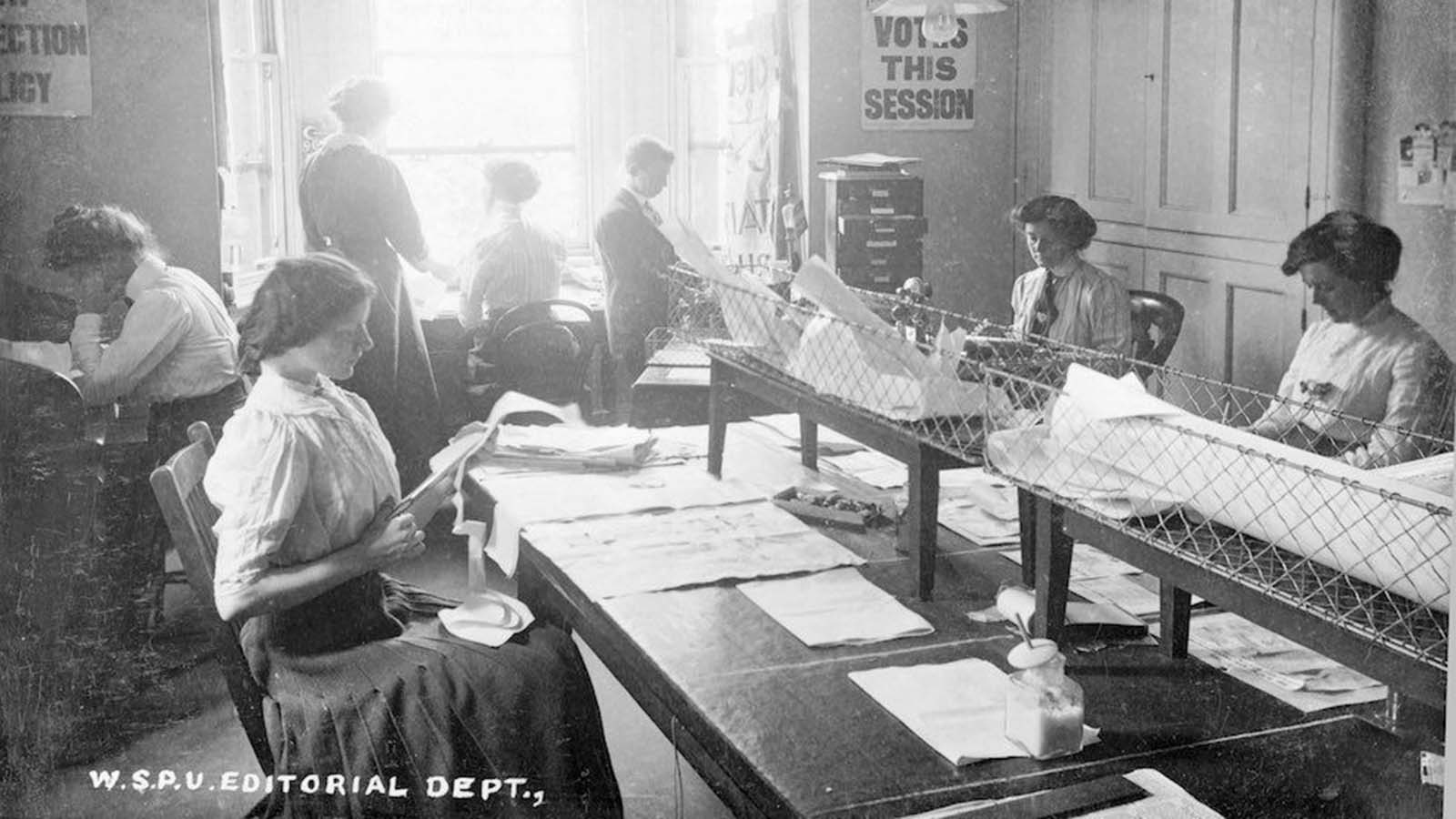
In the editorial department of Clement's Inn, located along The Strand in London, women are immersed in their tasks. Predominantly young female volunteers are assembled around the 'making-up table,' carefully cutting and pasting content for the current week's edition of 'Votes for Women.' They share a common hairstyle, with their hair loosely tied up in buns. Their attire predominantly consists of white blouses and full skirts, with two of them choosing to wear neckties. This scene vividly captures the essence of the year 1911.
The profound impact of WWII left the Western world grappling with scarcity. Essential supplies were limited, and even clothing materials were not exempted from this constraint. Throughout much of the 1930s, practicality took precedence, as women embraced roomy suits and understated accessories.
Furthermore, as men fought abroad in the early 1940s, numerous women found themselves tending crops and assuming roles traditionally viewed as 'male-oriented.' This transformation was directly mirrored in their clothing choices – durable denim overalls became their armor against the rigors of outdoor challenges.
The late 1940s witnessed a resurgence of 'conventional' femininity. Although cloth materials remained rationed, the spotlight shifted to unadorned tea dresses. Curly hairstyles and makeup were employed to counterbalance the austerity inherent in the 1940s cuts.
The 1950s marked the revival of the cinched waist, crafting striking feminine contours. Formal work attire remained conservative but saw the addition of white gloves and the introduction of voluminous 'poodle' skirts.
In the 1960s, the focal point shifted to the youth culture, which enjoyed abundant time and resources for indulging in popular trends and fashion statements. The era clamored for shorter skirts and more voluminous hair, and these desires were indeed met. Work attire echoed this transformation, with short and boxy jackets paired with tweed skirts. The iconic pink Chanel suit worn by Jackie Kennedy became a recurrent inspiration, recreated time and again.

An American secretary is positioned at a desk, situated behind a typewriter, while simultaneously handling phone calls to collect messages. She is dressed in black attire, and her blouse boasts a semi-sheer quality. Her hair is styled at neck-length, characterized by a permanent wave. This snapshot captures the year 1930.
The 1970s welcomed a fresh wave of feminism, as women began penetrating office environments, poised to challenge the dominance of patriarchal society.
Throughout the 1970s, women showcased a diverse array of styles, sparking debates over whether trousers or dresses were more suitable workplace attire. From bell-bottom jeans to the iconic Diane von Furstenberg wrap dress, women of the 1970s exuded flair and fashion.
Empowered by their burgeoning presence in the workforce, women of the 1980s harnessed fashion as a means to assert their influence. Power dressing, characterized by broad shoulder pads and daring jewelry choices, became a way for women to make a bold statement in professional settings.
Notwithstanding the extravagance of the 1980s, the 1990s marked a return to minimalism. The vibrant hues of the prior decade yielded to more subdued shades, aligning with the prevailing conservative aesthetic.
Shoulder pads were cast aside, and already short skirts evolved into micro minis. In this article, we will showcase an array of images illustrating women's workwear across the 20th century.

Within the railway works of Horwich, Lancashire, England, an office scene comes to life. Amid the First World War, numerous male rail workers heeded the call of duty and joined the military, prompting the employment of women to fill their roles. This encompassed an array of positions including blacksmiths, welders, and electricians.
In this office setting, most of the women opt for white blouses, which exhibit a more tailored fit compared to the previous image. Their hairstyles maintain an upswept form, albeit now with a slightly looser appearance. One woman, stationed by the card cabinets, allows her shoulder-length hair to flow freely, while another boasts long braids. Adding a touch of charm, at least two younger women adorn their hair with white bows.
Foregrounded on the left, a woman exemplifies a shorter skirt length and wears a leather shoe complete with a golfing-style flap. This snapshot encapsulates the year 1917.
 Amid the Christmas rush in England, women are diligently sorting mail at the post office. Their attire encompasses a variety of blouses, showcasing individual styles. Positioned at the forefront on the left, one woman opts for a cardigan and a tasteful set of pearls, exuding a touch of elegance. As with their earlier appearance, their hair is casually tied up, granting a sense of practicality. Meanwhile, the woman on the front-right dons a striped dress, marking the emergence of more patterned choices. This scene encapsulates the year 1920.
Amid the Christmas rush in England, women are diligently sorting mail at the post office. Their attire encompasses a variety of blouses, showcasing individual styles. Positioned at the forefront on the left, one woman opts for a cardigan and a tasteful set of pearls, exuding a touch of elegance. As with their earlier appearance, their hair is casually tied up, granting a sense of practicality. Meanwhile, the woman on the front-right dons a striped dress, marking the emergence of more patterned choices. This scene encapsulates the year 1920.
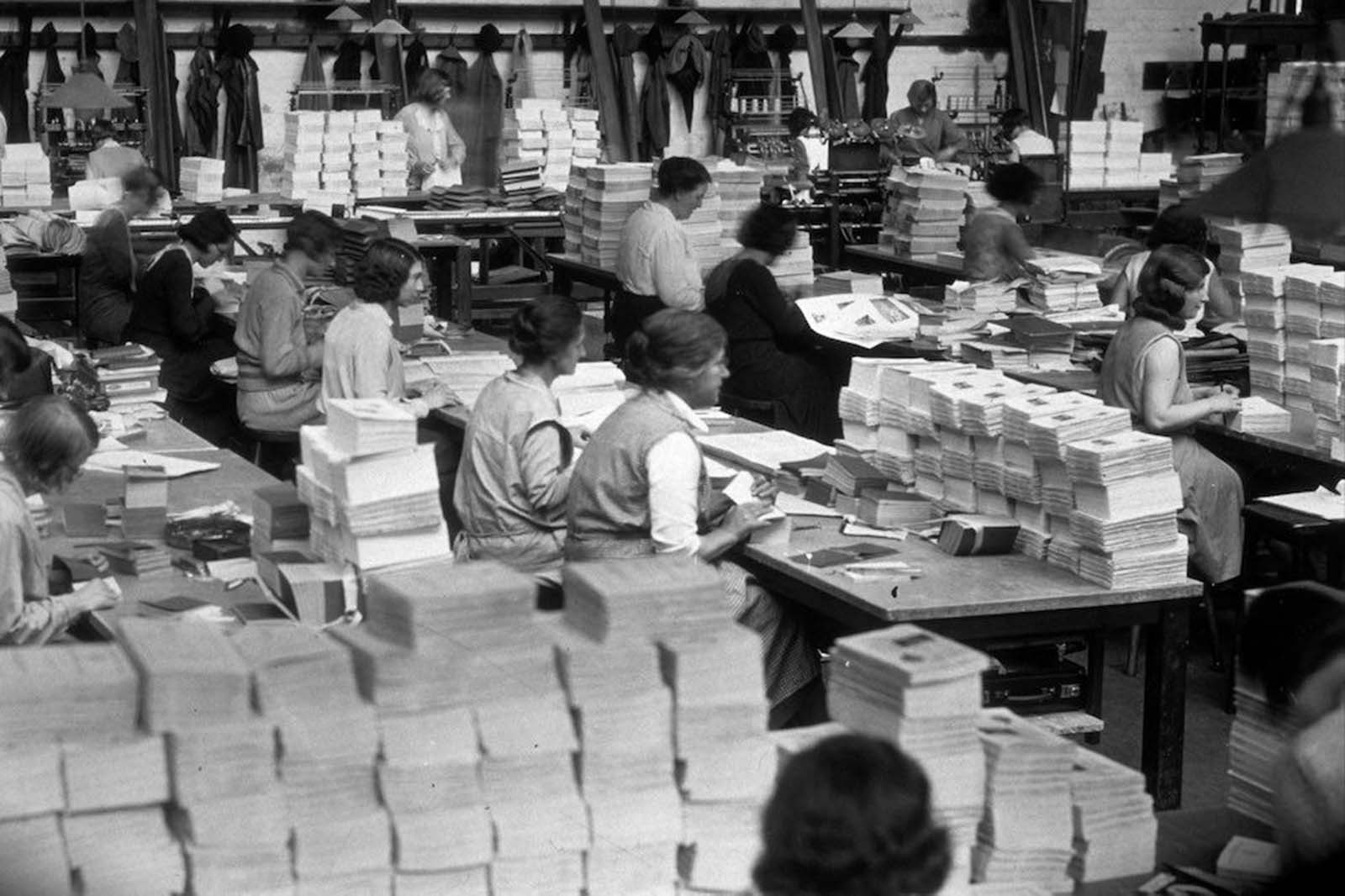 Engaged in tasks related to the conversion of the war loan, women are immersed in their work at the Government Printing and Stationery Office in Harrow, England. Among them, the older women adhere to the convention of tying their long hair up, while a group of younger counterparts sport shorter, shoulder-length hairdos. Several individuals opt for sleeveless over-dresses, imparting an air of practicality to their attire. Notably, one woman positioned on the right bares her arms. This tableau captures the year 1932.
Engaged in tasks related to the conversion of the war loan, women are immersed in their work at the Government Printing and Stationery Office in Harrow, England. Among them, the older women adhere to the convention of tying their long hair up, while a group of younger counterparts sport shorter, shoulder-length hairdos. Several individuals opt for sleeveless over-dresses, imparting an air of practicality to their attire. Notably, one woman positioned on the right bares her arms. This tableau captures the year 1932.
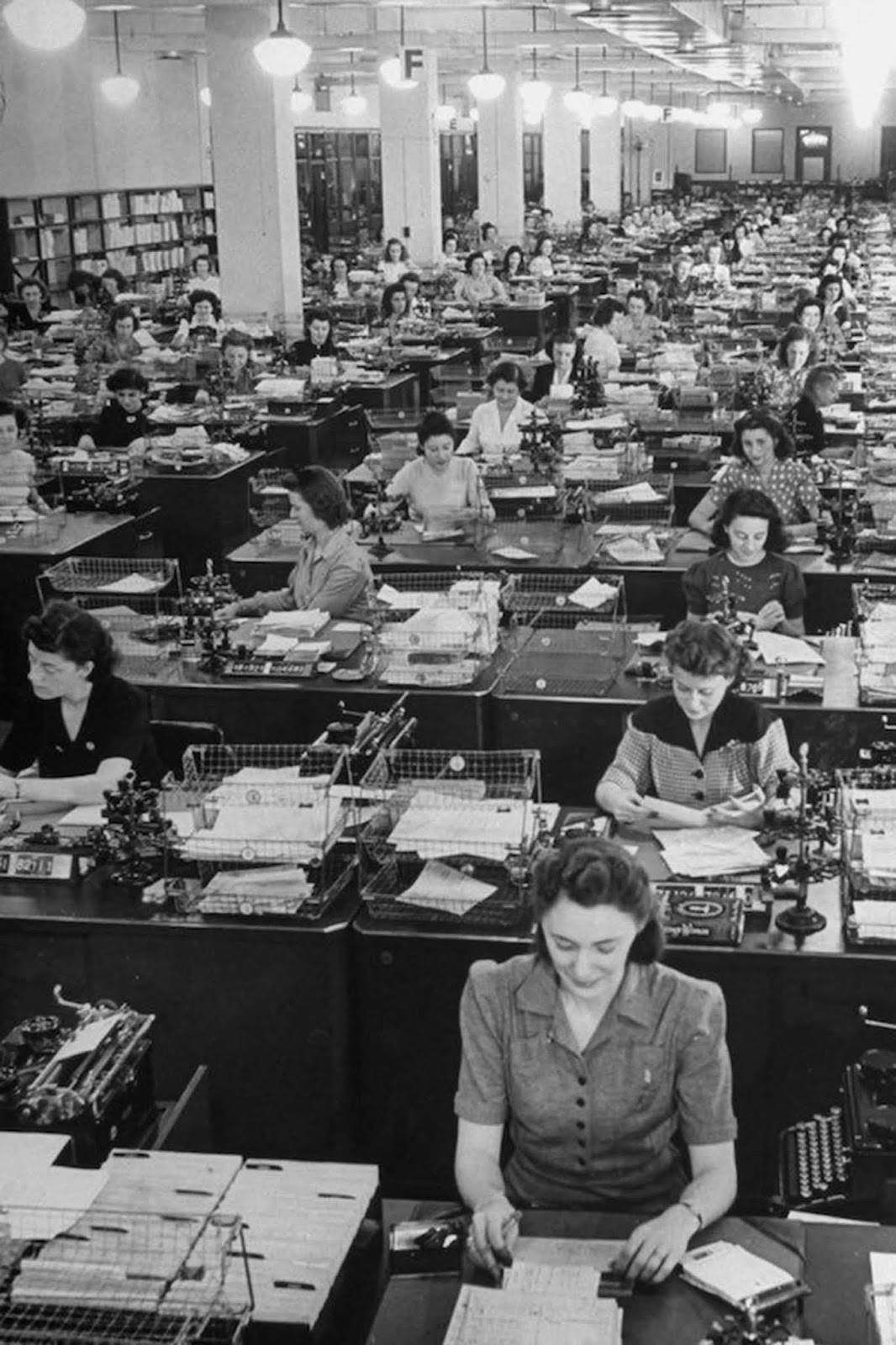 Within the office of the Book of the Month Club, a bustling scene unfolds as 325 American women diligently attend to filling mail orders. Their attire presents a diverse spectrum, featuring an array of blouses and dresses, some adorned with decorative patterns and polka dots. V-neck styles predominate, while a number of women accessorize with brooches. Sporting shoulder-length hair is the common trend, exemplified by the majority, while a woman at the forefront opts for a hair net. This vivid tableau captures the essence of the year 1942.
Within the office of the Book of the Month Club, a bustling scene unfolds as 325 American women diligently attend to filling mail orders. Their attire presents a diverse spectrum, featuring an array of blouses and dresses, some adorned with decorative patterns and polka dots. V-neck styles predominate, while a number of women accessorize with brooches. Sporting shoulder-length hair is the common trend, exemplified by the majority, while a woman at the forefront opts for a hair net. This vivid tableau captures the essence of the year 1942.
 In her third-floor office situated in New York, Eileen Ford, co-owner of the Ford Modeling Agency, is captured along with her husband as they respond to calls requesting their roster of 34 high-fashion models. Eileen Ford herself dons black attire, with her hair cut short, and is seen barefoot. This snapshot offers a glimpse into the year 1948.
In her third-floor office situated in New York, Eileen Ford, co-owner of the Ford Modeling Agency, is captured along with her husband as they respond to calls requesting their roster of 34 high-fashion models. Eileen Ford herself dons black attire, with her hair cut short, and is seen barefoot. This snapshot offers a glimpse into the year 1948.
 Featured in the pages of 'Picture Post' with its original caption, this image showcases a woman donning a black satin dress by Brenner. Adorned with delicate baby lace around the sleeves, neckline, and hemline, the ensemble exudes elegance. However, it's noted that this attire might not be entirely suitable for the office environment. This snapshot captures the essence of the year 1950.
Featured in the pages of 'Picture Post' with its original caption, this image showcases a woman donning a black satin dress by Brenner. Adorned with delicate baby lace around the sleeves, neckline, and hemline, the ensemble exudes elegance. However, it's noted that this attire might not be entirely suitable for the office environment. This snapshot captures the essence of the year 1950.
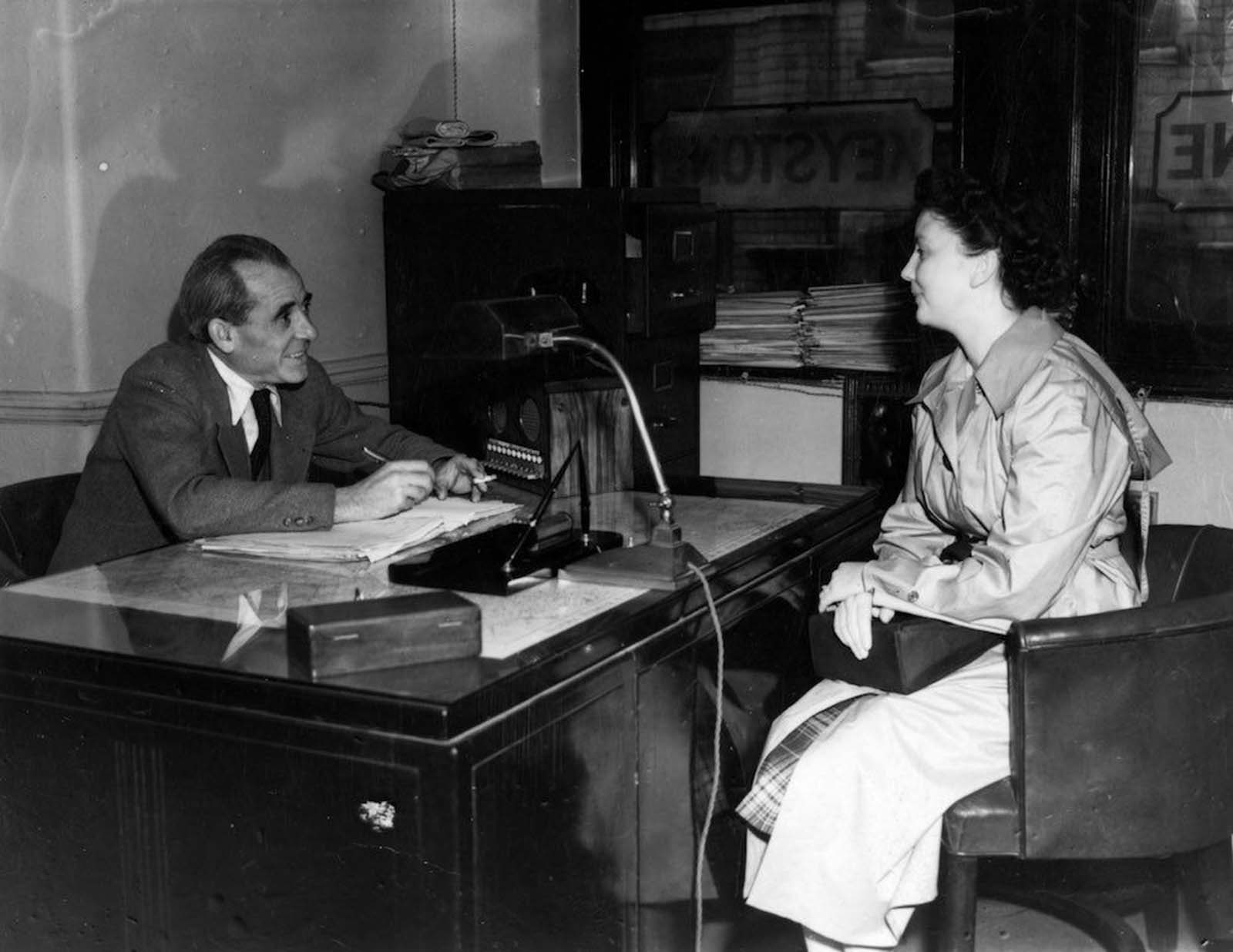 Within the confines of the Keystone photographic agency offices, a young woman is seen undergoing a job interview. Her male interviewer is attired in a tie and boasts a sizable collar, with a cigarette in hand. Notably, the woman retains her raincoat indoors, revealing a glimpse of her plaid skirt. Her long hair is elegantly tied up. This scene encapsulates the year 1950.
Within the confines of the Keystone photographic agency offices, a young woman is seen undergoing a job interview. Her male interviewer is attired in a tie and boasts a sizable collar, with a cigarette in hand. Notably, the woman retains her raincoat indoors, revealing a glimpse of her plaid skirt. Her long hair is elegantly tied up. This scene encapsulates the year 1950.
 In Union Square, San Francisco, California, a group of women office workers are captured enjoying their boxed lunches. Adorned in formal suits of conservative hues, their short hair is commonly parted at the side. Notably, all the women are observed wearing tan stockings or hose. This scene offers a glimpse into the year 1956.
In Union Square, San Francisco, California, a group of women office workers are captured enjoying their boxed lunches. Adorned in formal suits of conservative hues, their short hair is commonly parted at the side. Notably, all the women are observed wearing tan stockings or hose. This scene offers a glimpse into the year 1956.
 (Left) Within the typing pool at Shell Mex House in London, women are diligently engaged in their tasks. Positioned at the forefront, a woman dons a jacket and scarf, accentuated by a brooch and earrings. Her hair is stylishly cut short on her forehead, a trend shared by the other women depicted, who also sport waved hairstyles. This portrayal captures the essence of the year 1955.
(Left) Within the typing pool at Shell Mex House in London, women are diligently engaged in their tasks. Positioned at the forefront, a woman dons a jacket and scarf, accentuated by a brooch and earrings. Her hair is stylishly cut short on her forehead, a trend shared by the other women depicted, who also sport waved hairstyles. This portrayal captures the essence of the year 1955.
(Right) Seated at an illustrator's desk, another woman is clad in black attire, complemented by a turtleneck sweater. Her hair is notably cropped very short. This snapshot encapsulates the year 1957.




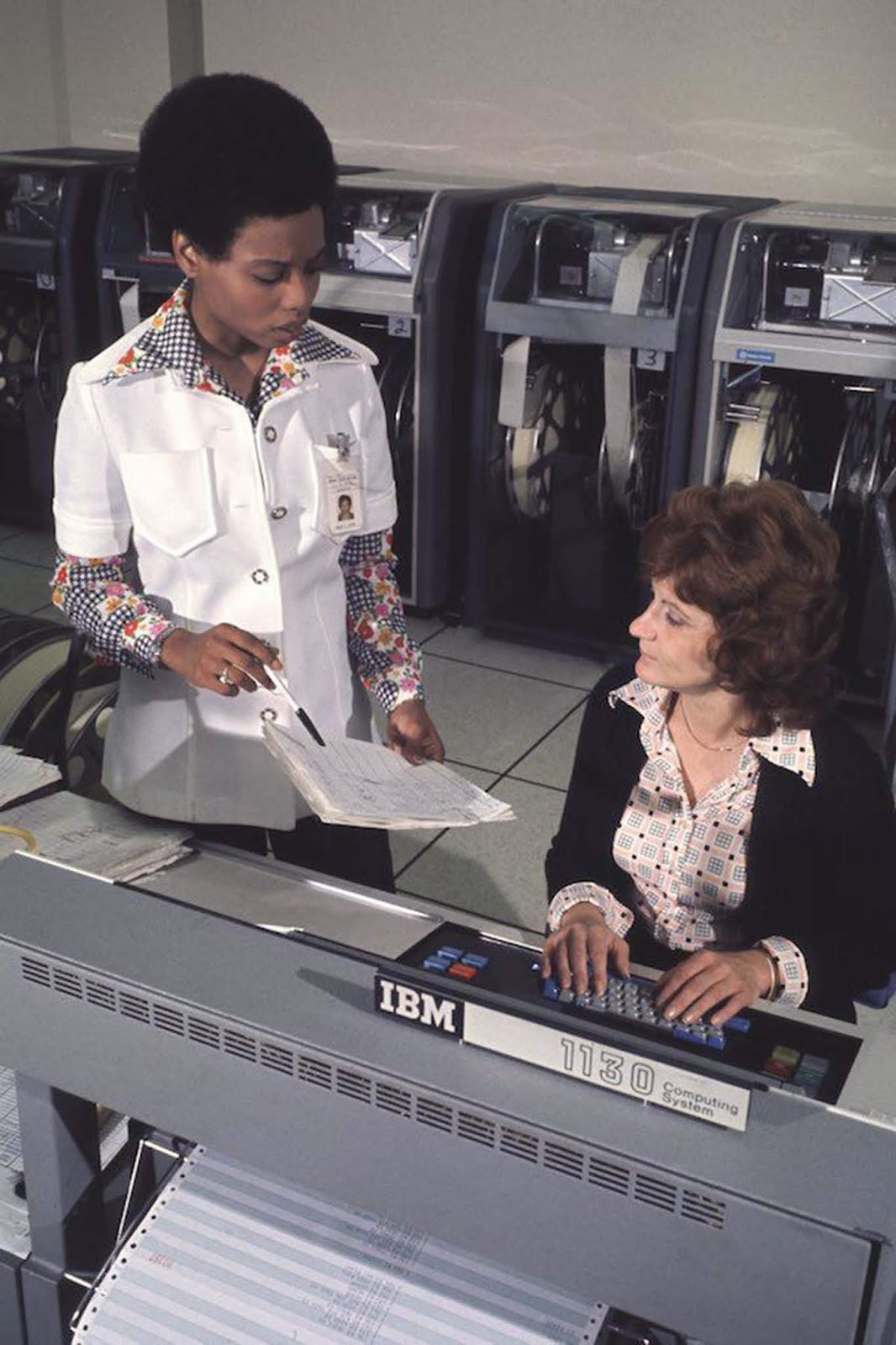
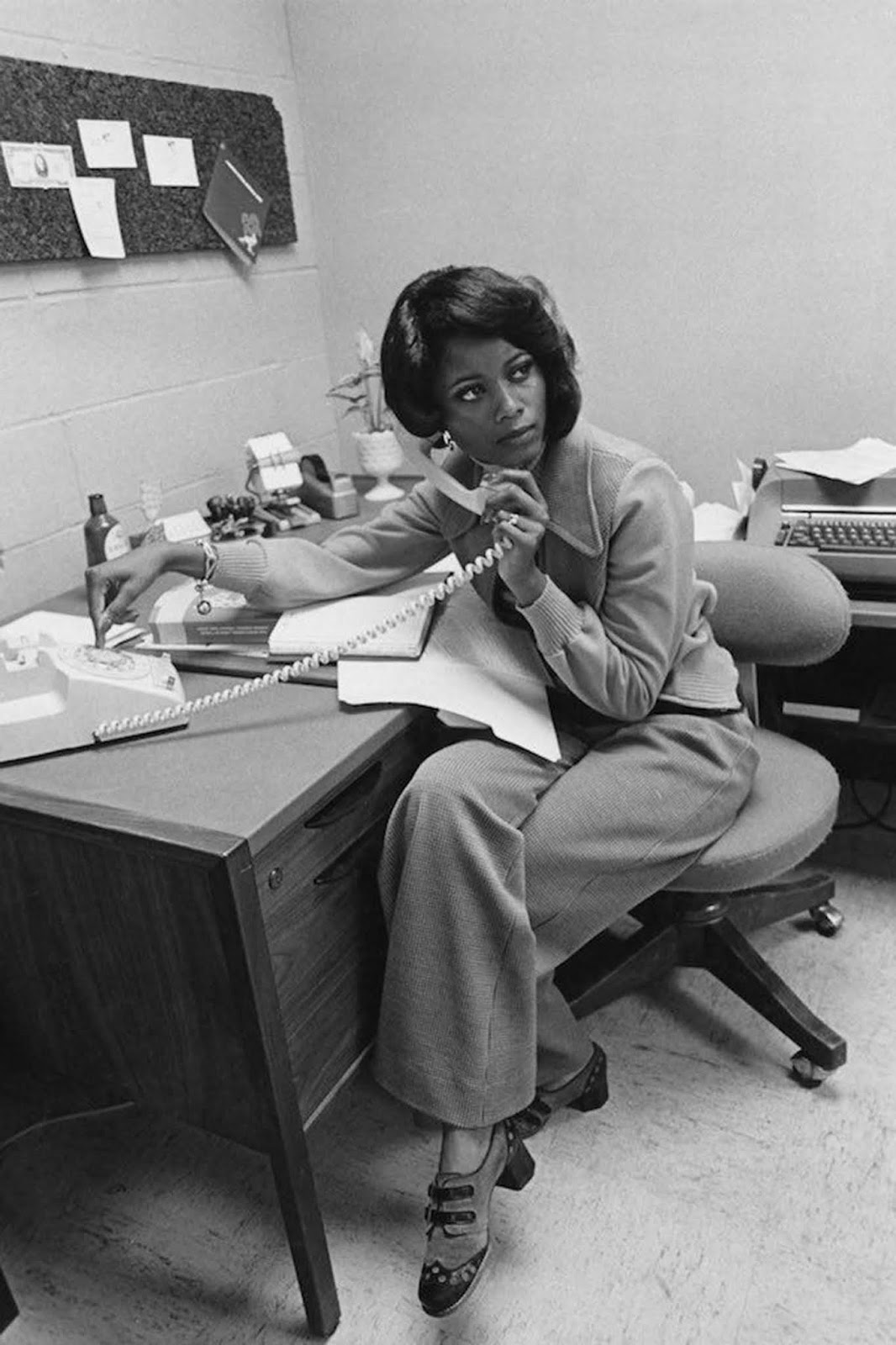



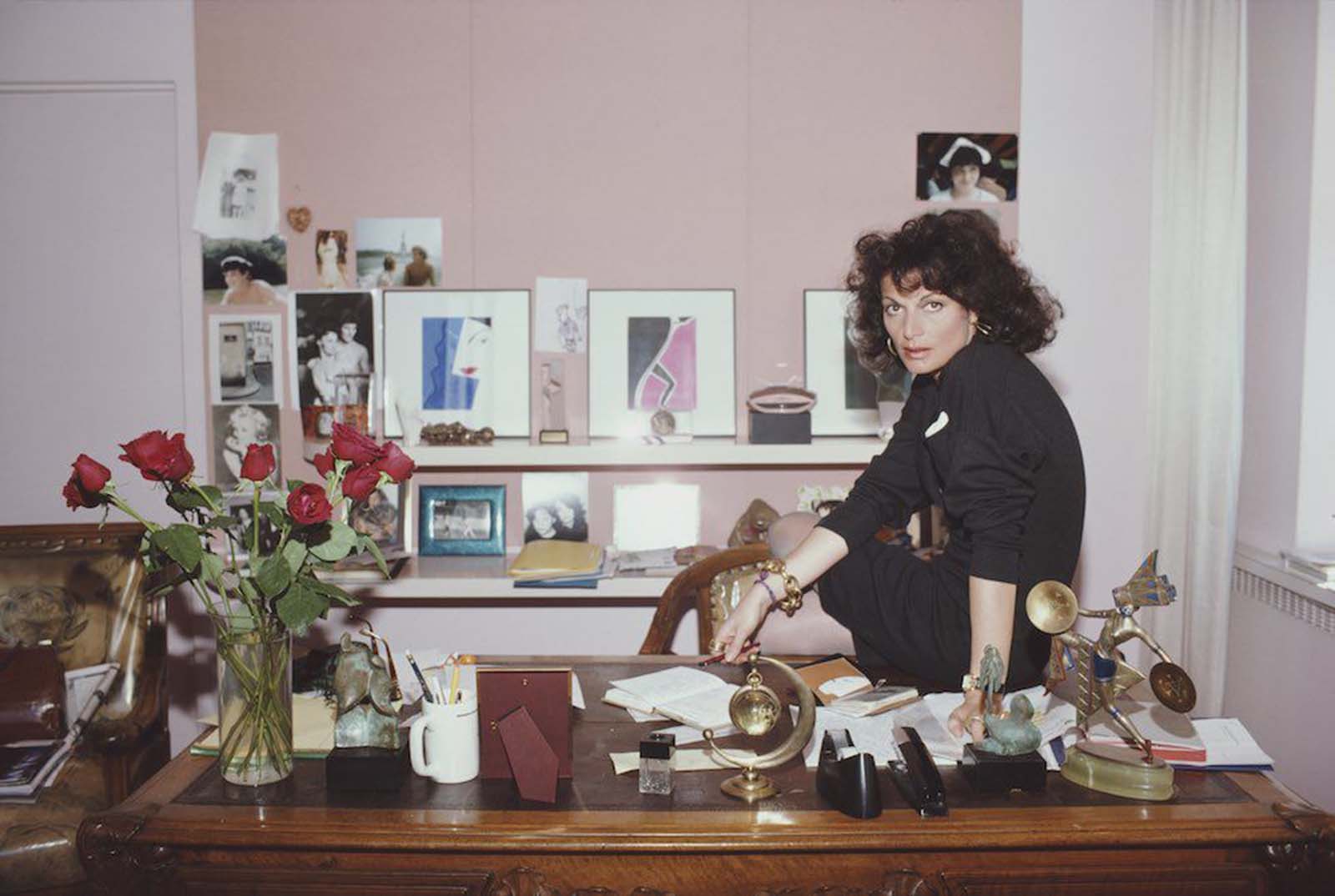




-1691828536x1024.jpg)

